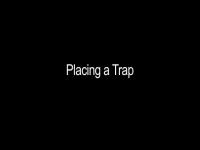Placing traps - blunder traps
Placement of blunder traps covers card blunder traps and flat plastic traps.
- Each trap location should be given an individual number. This should be written onto the trap and onto a floor plan to show the location of that number trap. This number stays with the location when the trap is changed.
- Write the date of placing the trap onto the trap. This may need to be written on a recording sheet if plastic traps are used.
- The trap locations should be on the floor, preferably in the corners of the room. Insect larvae crawl on the floor and adult insects spend much of their time crawling rather than flying. As a consequence, traps placed on shelves or on top of cupboards are largely ineffective.
- Only place traps in showcases if an infestation is present or the trap is felt to be the most effective way of monitoring.
- Ideally, place a trap in each corner of a room. Once a monitoring programme has established what the background insect populastion is and where they are found, it may be possible to reduce the number of traps.
- Try to poisition trpas where they will no be tordden on or stolen. Placing them under the edge of furniture or behind curtains is often ideal.
- If the room has an unsed fireplace, place a trap in the fireplace even if the chimney is capped. Debris may still be present in the chimney that can harbour insects.
- As a minimum, place traps in every area that contains vulnerable collections. Ideally, all rooms and spaces should be monitored to understand what the insect population of the building is, but this may not be possible.
- Be particularly careful if bats are present. If they are present, flat plastic traps should be used, or sides should be made for card blunder traps that reduces the opening on each side to 2mm. You may be prosecuted if a bat becomes stuck on a trap.
